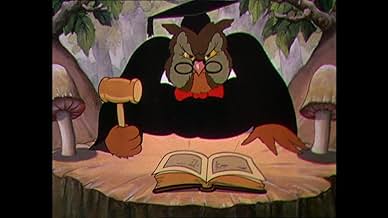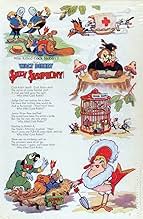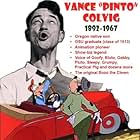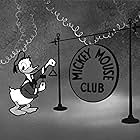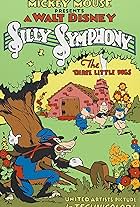VALUTAZIONE IMDb
6,9/10
898
LA TUA VALUTAZIONE
Aggiungi una trama nella tua linguaRobin is crooning to a Mae West-like Jenny Wren when he is shot with an arrow. A court is convened; the judge, an owl, keeps singing the title. A variety of birds are brought to the witness ... Leggi tuttoRobin is crooning to a Mae West-like Jenny Wren when he is shot with an arrow. A court is convened; the judge, an owl, keeps singing the title. A variety of birds are brought to the witness stand, but nobody knows a thing.Robin is crooning to a Mae West-like Jenny Wren when he is shot with an arrow. A court is convened; the judge, an owl, keeps singing the title. A variety of birds are brought to the witness stand, but nobody knows a thing.
- Candidato a 1 Oscar
- 2 vittorie e 1 candidatura in totale
Billy Bletcher
- Judge Oliver Owl
- (voce)
- (non citato nei titoli originali)
Don Brodie
- D.A. Parrot
- (non citato nei titoli originali)
Leo Cleary
- Irish Cop
- (non citato nei titoli originali)
Pinto Colvig
- Prosecutor Parrot
- (voce)
- (non citato nei titoli originali)
Melvin J. Gibby
- Cock Robin's Singing
- (non citato nei titoli originali)
Charles Lung
- Dan Cupid
- (non citato nei titoli originali)
Clarence Nash
- Legs Sparrow
- (voce)
- (non citato nei titoli originali)
Purv Pullen
- Cock Robin's Whistling
- (voce)
- (non citato nei titoli originali)
Nick Stewart
- Blackbird
- (voce)
- (non citato nei titoli originali)
Martha Wentworth
- Jenny Wren
- (voce)
- (non citato nei titoli originali)
Trama
Lo sapevi?
- ConnessioniFeatured in Sabotaggio (1936)
- Colonne sonoreCall To The Hunt
Sung by the Jury
Recensione in evidenza
This notable entry in Walt Disney's famous Silly Symphony series is perhaps best remembered for its parodies of current movie stars, including Bing Crosby, Harpo Marx, and -- most spectacularly -- Mae West, but seen today the film is even more striking for its subversive treatment of the legal system. The sassy attitude on display here smacks more of the Fleischer Studio or the wise-guy aggressiveness of Warner Brothers' Termite Terrace boys than what we usually get from Uncle Walt. This cartoon also appears to have just barely slipped past the newly strict Hays Office censors with its naughty insinuations (via Jenny Wren, the Mae West stand-in) and blatant "pansy" references.
For the first few moments after the opening credits the tone is typical of a Silly Symphony: Cock Robin croons a love song to his girlfriend, as we take in the rich palette of Disney's Technicolor flowers and trees. Abruptly, Cock Robin is bumped off, plummeting to the ground before the Old Crow Bar in what looks like the seedy part of the woods, and suddenly we're in a different universe. As the morgue orderlies carry Cock Robin away, one of them casually tosses his hat onto the arrow protruding from his chest. A nice dark touch, that.
Then the cops show up and roust three suspects out of the bar, and here's where things get really disturbing. All three suspects are dragged away and clubbed, but a black bird who talks like Stepin Fetchit and wears a white jacket is singled out for special brutality. Despite his protests that he "didn't do nuthin', don't know nuthin', and didn't see nuthin'" the black bird is clobbered repeatedly. The segue from the sequence before the trial to the trial itself is an amazingly bold cross-fade, timed to the rhythm of a cop clubbing this guy's head as it blends with the pounding of the judge's gavel. Eisenstein couldn't have done it better! And when the black bird repeats his denials, the jury mocks his cries with a minstrel show parody. It's only funny in the most grim sense of the word.
Am I being excessively P.C. in examining a Disney cartoon in this fashion? I don't think so, nor am I calling the filmmakers racist. The animators who made this cartoon seem to be taking a very bleak view of the justice system and playing their own cynicism for laughs, the way the Marx Brothers took on politics in Duck Soup. But I do wonder how the cartoon went over in cinemas in African American neighborhoods. Did black audiences laugh ruefully? Or watch in stony silence?
Beyond that, what's interesting to me about Who Killed Cock Robin? is the fact that, with the exception of Jenny Wren, the Hollywood caricatures really aren't central to the success of the whole. The Judge (an owl) and the D.A. (a parrot) are more impressive characters in terms of design than any of the others, and the jury acting as Greek Chorus is a great idea -- even if Gilbert & Sullivan thought of it first. Still, it's Jenny Wren we remember from this film, and this is where the animators and the uncredited performer who provided her voice really outdid themselves: this is a superb parody of Mae West that beautifully captures her look, her sound, her moves, and her style, especially in her courtroom musical number.
All in all this is a remarkable cartoon, and one that the Disney Organization would never have made after the mid-1930s. Once the war came, and forever after, Uncle Walt never sanctioned anything that could be deemed critical of the American Way of Life.
For the first few moments after the opening credits the tone is typical of a Silly Symphony: Cock Robin croons a love song to his girlfriend, as we take in the rich palette of Disney's Technicolor flowers and trees. Abruptly, Cock Robin is bumped off, plummeting to the ground before the Old Crow Bar in what looks like the seedy part of the woods, and suddenly we're in a different universe. As the morgue orderlies carry Cock Robin away, one of them casually tosses his hat onto the arrow protruding from his chest. A nice dark touch, that.
Then the cops show up and roust three suspects out of the bar, and here's where things get really disturbing. All three suspects are dragged away and clubbed, but a black bird who talks like Stepin Fetchit and wears a white jacket is singled out for special brutality. Despite his protests that he "didn't do nuthin', don't know nuthin', and didn't see nuthin'" the black bird is clobbered repeatedly. The segue from the sequence before the trial to the trial itself is an amazingly bold cross-fade, timed to the rhythm of a cop clubbing this guy's head as it blends with the pounding of the judge's gavel. Eisenstein couldn't have done it better! And when the black bird repeats his denials, the jury mocks his cries with a minstrel show parody. It's only funny in the most grim sense of the word.
Am I being excessively P.C. in examining a Disney cartoon in this fashion? I don't think so, nor am I calling the filmmakers racist. The animators who made this cartoon seem to be taking a very bleak view of the justice system and playing their own cynicism for laughs, the way the Marx Brothers took on politics in Duck Soup. But I do wonder how the cartoon went over in cinemas in African American neighborhoods. Did black audiences laugh ruefully? Or watch in stony silence?
Beyond that, what's interesting to me about Who Killed Cock Robin? is the fact that, with the exception of Jenny Wren, the Hollywood caricatures really aren't central to the success of the whole. The Judge (an owl) and the D.A. (a parrot) are more impressive characters in terms of design than any of the others, and the jury acting as Greek Chorus is a great idea -- even if Gilbert & Sullivan thought of it first. Still, it's Jenny Wren we remember from this film, and this is where the animators and the uncredited performer who provided her voice really outdid themselves: this is a superb parody of Mae West that beautifully captures her look, her sound, her moves, and her style, especially in her courtroom musical number.
All in all this is a remarkable cartoon, and one that the Disney Organization would never have made after the mid-1930s. Once the war came, and forever after, Uncle Walt never sanctioned anything that could be deemed critical of the American Way of Life.
I più visti
Accedi per valutare e creare un elenco di titoli salvati per ottenere consigli personalizzati
Dettagli
- Data di uscita
- Paese di origine
- Lingua
- Celebre anche come
- ¿Quién Mató a Robin?
- Azienda produttrice
- Vedi altri crediti dell’azienda su IMDbPro
- Tempo di esecuzione8 minuti
- Proporzioni
- 1.37 : 1
Contribuisci a questa pagina
Suggerisci una modifica o aggiungi i contenuti mancanti

Divario superiore
By what name was Chi ha ucciso Cock Robin? (1935) officially released in Canada in English?
Rispondi



